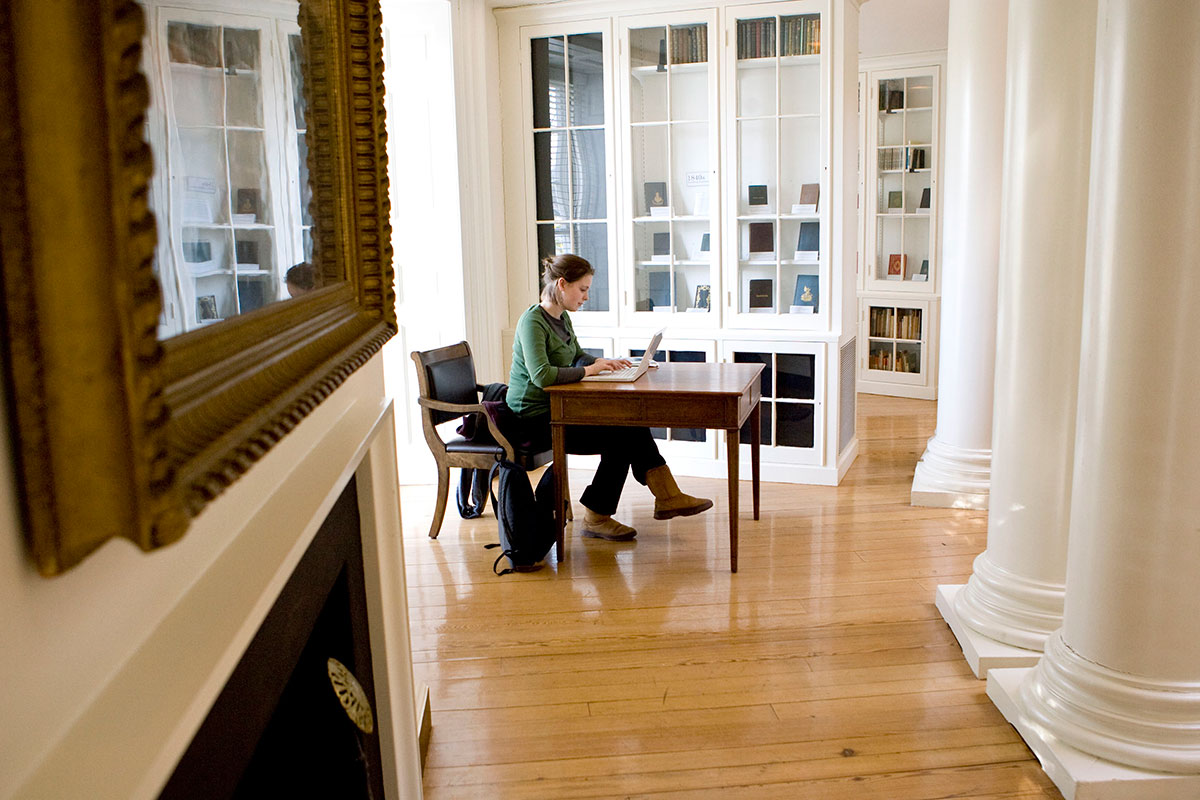When the Rotunda reopens in the fall, it will return to the center of student life at the University of Virginia.
“The Rotunda is the symbol of the institution,” said Brian Hogg, senior preservation planner in the Office of the Architect. “It is the most important building on the Grounds, the most important building in the state and it is part of a World Heritage Site. We need to use it and to make sure that students get inside the building, because they have not always felt welcome in the past.”
After undergoing two years of renovation, the Rotunda will host classes and be open to students for studying as well as for socializing.
The renovation has replaced the roof, installed new marble capitals atop the columns on the north and south porticos, and created an underground mechanical room to house all-new air conditioning, wiring, plumbing, fire and safety controls, and wireless communications systems. The goal of the renovation is to equip the building with 21st-century amenities while retaining its evocation of 19th-century character.
UVA founder Thomas Jefferson originally designed the Rotunda to house classrooms and the University’s library. After the 1895 fire that extensively damaged the building, New York architect Stanford White expanded those uses, adding two north wings that first served as classrooms, and later hosted the expanded library. This role ceased in the late 1930s, when the library moved into the newly constructed Alderman Library.
The library’s move across McCormick Road more or less ended regular student involvement in the building, save for a few special events. The wings were converted into office space, while the central part of the building remained without dedicated uses. In the 1970s, the McKim, Mead and White interior was removed and replaced with a recreation of the Jefferson design.
University historian Alexander “Sandy” Gilliam said that in the 1950s, when he was a student, his peers entered the Rotunda at night because there was a soda machine and a pay telephone on the ground floor.
“I can’t remember that any of us ever tried to study in the Rotunda,” he said. “It just simply was not used.”
That soon will change, with a variety of classes to be held in the Rotunda, starting in the fall, and with extended hours for students to be able to study in the building.
The southeast wing will hold two classrooms, which will host classes five days a week. The Lower West Oval Room will be used three days a week for University Seminars and College Advising Courses, known as COLAs, which enroll primarily first-year students.
“We want to invite first-year students into the Rotunda early to engage them early in an active community,” said M. Wynne Stuart, associate provost for academic support and classroom management.
Stuart said the two classrooms in the southeast wing will be scheduled as any other classroom, with about 40 classes meeting each week. The Lower West Oval Room will host 18 to 24 classes per week, bringing in between 360 and 400 students. No classroom assignments have been made yet for the fall term.
“There is a lot of demand for the three classrooms in Pavilion VIII, so I imagine there will be for these as well,” she said.
Before the Rotunda closed for renovations, a pilot program used the Lower West Oval Room for University Seminars and advisory classes – programs for which professors propose topics, which could be variations of classes they already teach or new topics they want to explore.
“We ran the pilot program for two years,” Stuart said. “We wanted to convey the idea that the Rotunda is a living building, not just a museum that people come to visit.”
Stuart pronounced the pilot program a success, with faculty willingly moving to the Rotunda to teach the courses. Student study hours, also a part of the pilot program, received a positive response.
Under the new, expanded study hours, students will have access to the Rotunda from 5 p.m. to 10 p.m. three days a week, with additional hours during examination periods, to use the Upper West Oval Room, the Dome Room and the middle gallery. Comfortable furniture will be available for the students throughout the Rotunda.
“There will be tables and chairs in the alcoves and in center of the Dome Room, and a mix of tables and upholstered furniture in the middle gallery,” Hogg said.
The Rotunda will also be a hub of social activity, Hogg said, with the re-launching of Dome Room Dinners, formal affairs for first-year students grouped by residence hall associations.
“This is a tradition that goes back years,” said Andrew Petters, an assistant dean of housing and residence life. “This is a special way for the first-years to get to know the Rotunda and the Academical Village and a way for the first-year students in each dorm to have a shared experience.”
The students dress up for the dinners, Petters said. “This is not something they just run to from class,” Petters said. “This is something that they go back to their rooms and get ready for.”
The students gather at their dorms and walk to the Rotunda as a group. The Rotunda hosts one dinner per week for first-years, each seating about 88 diners, and Petters said that all first-year students have an opportunity to sign up. The senior resident selects the menu, with vegetarian options, through UVA Dining Services.
The Rotunda also hosts some dinners for upperclassmen, such as second-year students who live on-Grounds and transfer students, Petters said.
Dinners of various kinds in the Dome Room have been a regular tradition since the Rotunda reopened following the 1970s renovation, when then-President Frank Hereford wanted to encourage more student activity in the building, Gilliam said. These dinners will continue Thursday through Saturday nights.
Media Contact
Article Information
February 18, 2016
/content/open-house-renovated-rotunda-will-be-more-welcoming-students

